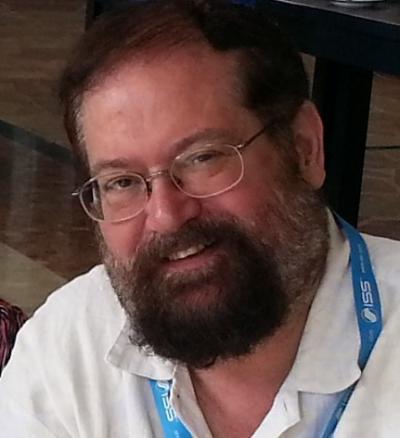
Research Topics
Visualizing the workings of living cells has transformed biological understanding. Today, optical technologies allow us to learn about the role of individual macromolecules in cells embedded within living tissues, but there is still plenty of room for improvement in non-destructive resolution, speed, and sensitivity. Dr. Knutson has brought his training in optical physics to create better instruments and software for examining the inner workings of cells and macromolecular complexes.
Dr. Knutson is also working to develop novel fluorescent probe molecules for imaging cellular levels of things like oxygen, free radicals and NADH energy. These reporter probes are actually manufactured by the cells themselves, in response to either “transfected” DNA segments or a specific, innocuous virus. They, for example, tether the protein MB=myoglobin (the protein that changes the color of, e.g., a steak gone bad) with either red or yellow fluorescent proteins. The fluorescence of these partners is responsive to those MB color changes; in particular, the fluorescence lifetime (the nanosecond ‘halflife’ of the light emitting state) can be directly imaged to see whether or not the MB has oxygen bound, or whether it has been attacked by radicals.
In collaboration with other NHLBI and NIH labs, this has enabled studies of oxygen and radical effects on transcription within cell nuclei , along with studies of mitochondrial dysfunction in non-alcoholic fatty liver disease and aggressive cancer-related metabolic switching in hypoxia. Most work on these has been in cell culture, but application to tissue has begun. The laboratory’s earlier work on two-photon microscopy devices allows investigators to see into tissue while avoiding laser tissue damage.
Dr. Knutson has also had a long-standing interest in studying the movement and interactions of RNA and DNA. Base analogs that fluoresce can be carefully and specifically placed among the regular RNA or DNA bases to report local structure. Further, collaborators have developed novel “turn-on aptamers” that use rigid RNA structure that immobilize floppy non-fluorescent molecules, bracing them and thus turning them into good fluorescent reporters. Dr. Knutson and his colleagues have built new instruments to study that immobilization with a time range (picoseconds) that is hundreds of times faster than conventional fluorescence spectroscopy.
Dr. Knutson also works on the fundamental (diffraction) limits of optical resolution spots. Pioneers like Prof. Stefan Hell circumvented the limit by applying a second, donut shaped laser beam to erase the edges of a spot, leaving behind a “superresolved” image - 10X finer. Those microscopes applied so much laser power, however, that one could not take non-destructive “cell movies”. Dr. Knutson responded by inventing novel “antenna” dyes to amplify the donut beam effect. This reduces laser bleaching and enables multicolor imaging. The lab also developed (in collaboration with the microscopy core facility) a ‘benchmarking’ protocol to verify the day to day precision of these donut beam methods.
Biography
Jay Knutson received his M.S. in 1975 and Ph.D. in 1978 from the University of Minnesota in Minneapolis. He was a postdoctoral fellow at the Freshwater Institute and from 1980 to 1984, at Johns Hopkins University. Before being named Chief of the Optical Spectroscopy Section in 1999, Dr. Knutson was a senior staff fellow in the NHLBI’s Laboratory of Technical Development from 1984 to 1989, and a research biophysicist in the Laboratory of Cell Biology from 1990 to 1999. He has authored or coauthored more than 107 papers. Dr. Knutson is a member of the Society of Photo-Optical Instrument Engineering and American Association for the Advancement of Science.
He is the former (2021) chair of the Biological Fluorescence Subgroup, Biophysical Society.
He was also elected to the Johns Hopkins University Society of Scholars.
Selected Publications
- Penjweini R, Link KA, Qazi S, Mattu N, Zuchowski A, Vasta A, Sackett DL, Knutson JR. Low dose Taxol causes mitochondrial dysfunction in actively respiring cancer cells. J Biol Chem. 2025;301(5):108450.
- Penjweini R, Roarke B, Alspaugh G, Link KA, Andreoni A, Mori MP, Hwang PM, Sackett DL, Knutson JR. Intracellular imaging of metmyoglobin and oxygen using new dual purpose probe EYFP-Myoglobin-mCherry. J Biophotonics. 2022;15(3):e202100166.
- Mori MP, Penjweini R, Knutson JR, Wang PY, Hwang PM. Mitochondria and oxygen homeostasis. FEBS J. 2022;289(22):6959-6968.
- Parry HA, Willingham TB, Giordano KA, Kim Y, Qazi S, Knutson JR, Combs CA, Glancy B. Impact of capillary and sarcolemmal proximity on mitochondrial structure and energetic function in skeletal muscle. J Physiol. 2024;602(9):1967-1986.
- Xu X, Penjweini R, Székvölgyi L, Karányi Z, Heckel AM, Gurusamy D, Varga D, Yang S, Brown AL, Cui W, Park J, Nagy D, Podszun MC, Yang S, Singh K, Ashcroft SP, Kim J, Kim MK, Tarassov I, Zhu J, Philp A, Rotman Y, Knutson JR, Entelis N, Chung JH. Endonuclease G promotes hepatic mitochondrial respiration by selectively increasing mitochondrial tRNA(Thr) production. Proc Natl Acad Sci U S A. 2025;122(1):e2411298122.
Related Scientific Focus Areas

Biomedical Engineering and Biophysics
View additional Principal Investigators in Biomedical Engineering and Biophysics

Molecular Biology and Biochemistry
View additional Principal Investigators in Molecular Biology and Biochemistry


This page was last updated on Tuesday, September 2, 2025